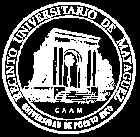|


| |
  University
of Puerto Rico. Mayagüez Campus University
of Puerto Rico. Mayagüez Campus
College of Engineering.
Industrial Engineering
Department
| Course
Syllabus |
|
General Information
Course Number: InIn 6046
Course Title: Advanced Industrial
Experimentation
Credit-Hours: Three
|
| Course Description
Applications, analogies and differences
among confidence intervals, prediction intervals, and tolerance intervals.
Fundamental concepts and applications of response surface methodology and
evolutionary operations to manufacturing processes. Case study of
manufacturing experiments with dichotomous or polytomous response
variables. Use of logistic regression for modeling the relationship
between a categorical variable and a set of covariates. Effective modeling
strategies and the interpretation of results are emphasized. Fundamental
concepts in the design and analysis of experiments with mixtures.
Statistical data analysis.
|
|
Prerequisites
InIn6005: Experimental Statistics, or
InIn4027: Design and Analysis of
Engineering Experiments.
|
|
Textbook and References
 |
Hahn, G.J. and Meeker, W.Q.,1991, Statistical
Intervals: a Guide for Practitioners, John Wiley and Sons,
New York. [H&M] |
 |
Agresti, A., 1990, Categorical Data
Analysis, John Wiley and Sons, New York. |
 |
Artiles-León, N., 1993, Reducing Label
Nonconformances by DOE and Logistic Regression, 47th. ASQC Quality
Congress Transactions, Boston, [Art1]. |
 |
Artiles-León, N. 1996, "A
Pragmatic Approach to Multiple-Response Problems Using Loss
Functions", Quality Engineering. Vol 9 No 2. [Art2]. |
 |
Box, G.E.P. and Draper, N.R.,1987,
Empirical Model-building and Response Surface, John Wiley and Sons,
New York. |
 |
Box, G.E.P. and Draper, N.R.,1969,
Evolutionary Operations, John Wiley and Sons, New York. |
 |
Cornell, J.A., Experiments With
Mixture, 2nd. Ed., John Wiley and Sons, New York, 1990.[Crn1] |
 |
Cornell, J.A.,1990, How to Run Mixture
Experiments For Product Quality, ASQC Press, [Crn2] |
 |
Cornell, J.A.,1990, How to Apply
Response Surface Methodology, ASQC Press. [Crn3] |
 |
Draper, N., and Smith, H.,1981, Applied
Regression Analysis, 2nd. Edition, John Wiley and Sons, New York. |
 |
Gunst, R.F.,and Mason R.L.,1990, How to
Construct Fractional Factorial Experiments, ASQC Press,. |
 |
Khuri, A.I. and Cornell, J.A., 1987,
Response Surface, Design And Analysis, Marcel Dekker, Inc., New York. |
 |
Mason, R.L., Gunst, R.F., and Hess, J.L.,1989,
Statistical Design and Analysis of Experiments, John Wiley and Sons,
New York. |
 |
Montgomery, D.C.,1997, Design And
Analysis of Experiments, 4th. Ed., John Wiley and Sons, New York, [Mont]. |
 |
Myers, R.H.,1990, Classical And Modern
Regression With Applications, 2nd. Ed., PWS-Kent Publishing Co.,
Boston,. [Myer] |
 |
Nelson, L.S. Transformation for
Attribute Data, Journal of Quality Technology, 15, pp. 55-56. [Nels] |
 |
Pignatiello, J. J. Jr., May 1993,
Strategies For Robust Multiresponse Quality Engineering, IIE
Transactions,, 25(3), pp. 5-15. [Pign] |
|
|
Purpose
This course is primarily designed for
majors in Industrial Engineering (IE) at the graduate level; however, it
is appropriate for science and engineering graduate students interested in
experimental design. The purpose of the course is to prepare students for:
i) mastering the theoretical and applied framework to design, conduct, and
analyze specialized experimental designs such as: response surfaces,
mixture experiments, categorical and multiple response variables
experiments and ii) conducting meritorious research in the experimental
design area. Emphasis is placed on effective modeling strategies and
interpretation of results and in the use of statistical software packages
as well. This course is an elective in the M.E. in IE.
|
|
Course Goals
At the completion of this course students
will be able to:
 |
Clearly distinguish the differences
between confidence, prediction, and tolerance intervals. |
 |
Design and perform experiments with
mixtures. |
 |
Design experiments with mixtures with
constraints in the components proportions. |
 |
Use Stat Graphics, SAS, MINITAB, or
other statistical package to analyze experiments with mixtures. |
 |
Design and perform experiments with a
discrete response variable. |
 |
Use S Plus, StatGraphics, SAS, MINITAB,
or other statistical package to analyze experiments with a discrete
response variable. |
|
|
Requirements
All students are expected to come to class
on time, and prepared; do all assigned readings and related homework;
actively participate in class discussions; and satisfy all assessment
criteria to receive credit for the course.
|
|
Department and Campus
Policies
Class attendance: Class
attendance is compulsory. The University of Puerto Rico, Mayagüez Campus,
reserves the right to deal at any time with individual cases of
non-attendance. Professors are expected to record the absences of their
students. Frequent absences affect the final grade, and may even result in
total loss of
credits. Arranging to make up work missed
because of legitimate class absence is the responsibility of the student.
(Bulletin of Information Undergraduate Studies)
Absence from examinations:
Students are required to attend all examinations. If a student is absent
from an examination for a justifiable reason acceptable to the professor,
he or she will be given a special examination. Otherwise, he or she will
receive a grade of zero of "F" in the examination missed.
(Bulletin of Information Undergraduate Studies)
Final examinations: Final
written examinations must be given in all courses unless, in the judgment
of the Dean, the nature of the subject makes it impracticable. Final
examinations scheduled by arrangements must be given during the
examination period prescribed in the Academic Calendar, including
Saturdays. (see Bulletin of Information Undergraduate Studies).
Partial withdrawals: A
student may withdraw from individual courses at any time during the term,
but before the deadline established in the University Academic Calendar.
(see Bulletin of Information Undergraduate Studies).
Complete withdrawals: A
student may completely withdraw from the University of Puerto Rico,
Mayagüez Campus, at any time up to the last day of classes. (see Bulletin
of Information Undergraduate Studies).
Disabilities: All the
reasonable accommodations according to the Americans with Disability Act
(ADA) Law will be coordinated with the Dean of Students and in accordance
with the particular needs of the student.
Ethics: Any academic
fraud is subject to the disciplinary sanctions described in article 14 and
16 of the revised General Student Bylaws of the University of Puerto Rico
contained in Certification 018-1997-98 of the Board of Trustees. The
professor will follow the norms established in articles 1-5 of the Bylaws.
|
|
Course
Outline and Schedule
|
|
Week
|
Topic
|
Readings
|
|
1
|
Experimental designs for
fitting response surfaces. Central composite designs. Box-Behnken designs.
Geometric designs
|
[H&M] Ch.
1.
[Mont] Secs. 14.1 to 14.4 |
|
2
|
Strategies for multiresponse
quality engineering. Case of study
|
[Pign] and
[Art2]
|
|
3
|
Evolutionary operations.
Organization and implementation of EVOP programs. Two variable and
three-variable EVOP
|
[Mont] Sec. 14.6
|
|
4
|
Statistical Intervals:
Introduction and assumptions. Overview of different types of statistical
intervals. Use of tables for constructing statistical intervals for a
normal population
|
[H&M] Chapters
2 and 3 |
|
5
|
Computing statistical
intervals for a normal population
|
[H&M] Chapter 4
|
|
6
|
Distribution-free statistical
intervals. Sample size requirements
|
[H&M] Chaps. 5, 8 and 9
|
|
7
|
The general mixture
experiments
|
[Crn2] Ch. 1
|
|
The simplex-lattice designs
and associated polynomial models
|
[Crn2] Ch. 2
|
|
9
|
Multiple constraints on
proportions; the XVERT algorithm
|
[Crn2] Ch. 3
|
|
10
|
The analysis of mixture data
|
[Crn2] Ch. 4
|
|
11
|
Experiments with a binary
response. Transformations for attribute data Weighted regression. Logistic
regression
|
[Nels]
[Myer] Secs. 7.1 & 7.4 |
|
12
|
Maximum likelihood estimation
for grouped and ungrouped data. Estimation and standard error of the
coefficients. Case study
|
[Myer] Sec. 7.4
[Art1] |
|
14
|
Experiments with a polytomous
variable. Examples
|
Class notes
|
|